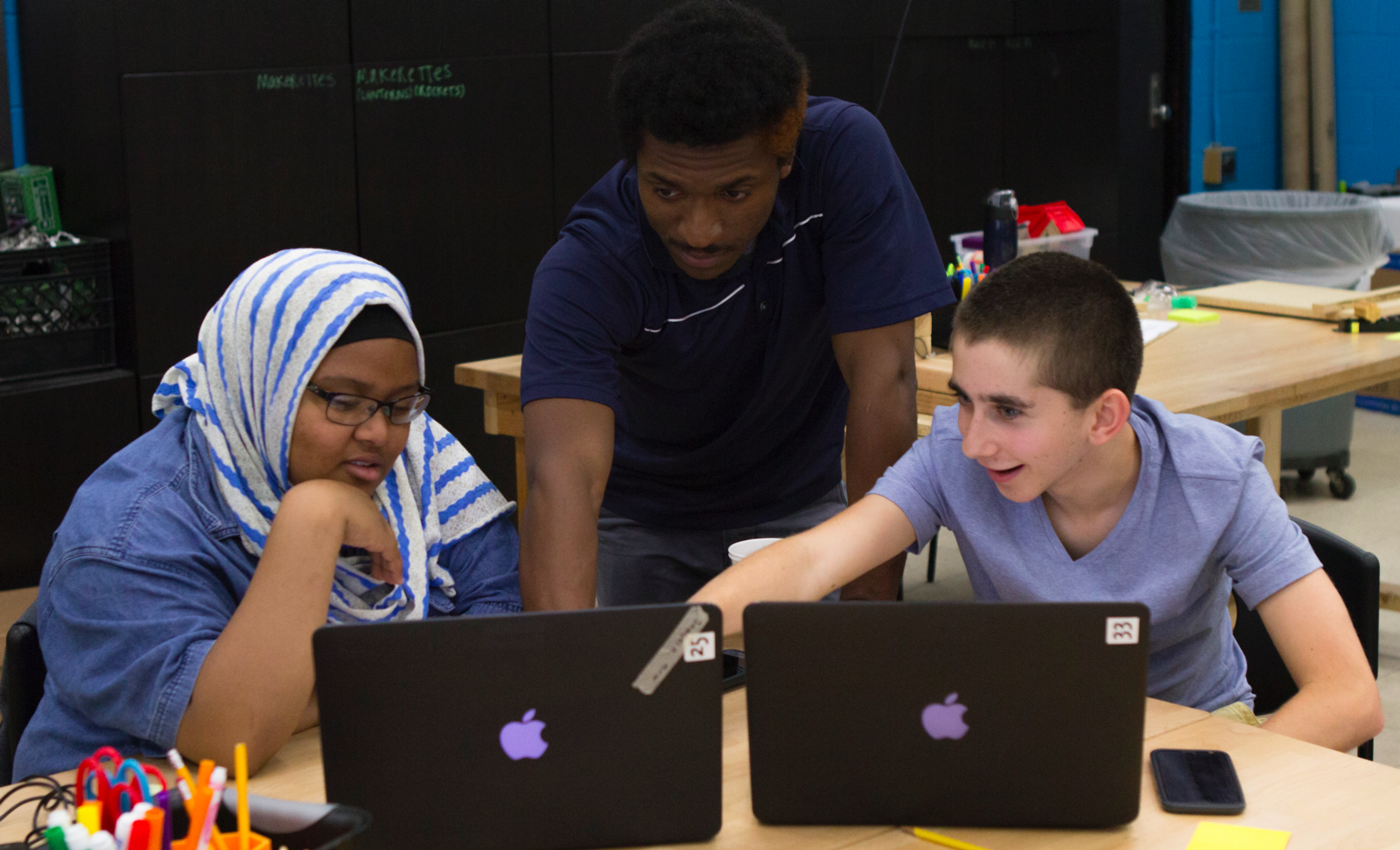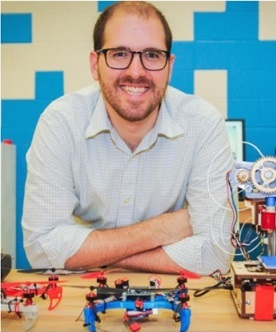Program Profiles
How do successful afterschool STEM programs do it?
These innovative afterschool programs offer impactful STEM programming to diverse populations. Read on to hear their advice for success and to learn about their program structure, evaluation results and partnership models.
Digital Harbor
The Digital Harbor Foundation is dedicated to fostering learning, creativity, productivity, and community through education. We achieve this through two divisions: (1) DHF Tech Center, year-round technology programs for youth grades 3-12; and (2) the Center of Excellence for Innovation in Technology Education (COE), which provides capacity-building professional development and consulting to educators and institutions who want to leverage tech learning, innovation, and creativity into their own learning environments.
Since 2013, we have served over 5,000 youth from 53 Baltimore-area zip codes, including 1,518 youth in 2017. Of these youth, 69% are minorities, 76% are from low-income families, and 41% are female. Another 1,570 community members participated in our special events.
Over 1,300 educators benefited from our in-person workshops and online resources in 2017. We held 45 workshops with 418 attendees, with an estimated indirect impact on 31,590 youth. Another 894 educators have accounts on DHF Blueprint, our online educator resource.
The Digital Harbor Foundation provides a comprehensive pathway for youth to gain the skills they need in order to thrive in the modern workforce, particularly in high-growth tech fields. This pathway offers two Academy Tracks in web development and digital fabrication, allowing youth to easily specialize their skill sets. Although youth are certainly not locked into these Tracks, they provide a clear framework for progression to help youth achieve their educational and employment goals at DHF and prime them for success in higher education and careers once they graduate high school.
Each Academy Track has 3 primary components (1) Introduction to fundamental technologies and problem-solving skills (2) Deeper exploration of topics included in each pathway (3) Advanced application of skills.
Introduction to Fundamental Technologies and Problem-Solving Skills
Youth complete 2 introductory courses designed to familiarize them with the skills and technologies offered at DHF and to help them begin specializing in each pathway.
Maker Foundations: Maker Foundations is DHF’s flagship entry-level course in technology, creativity, and making. In 14 weeks, youth are introduced to the technologies included in both the digital fabrication and the web development pathways through a series of hands-on modules in subjects like 3D printing, computer programming, electronics, and graphic design.
Core Courses: Once youth finish Maker Foundations, they will complete a Core Course in the pathway that most interests them. Core courses provide more detailed dives into the skills and technologies included in each pathway and will prepare youth for more advanced courses.
Deeper Exploration of Topics (Member Courses)
DHF offers a series of “Member Courses,” which provide deeper dives into specific skills or technologies included in each pathway. These courses could include video game development, advanced 3D printing, web development, and 2D fabrication using laser cutters and CNC mills.
Advanced Application of Skills
Youth are invited to apply the skills they have developed in our Introductory and Member Courses in advanced study and employment opportunities.
College Credit: DHF youth can earn credit for Digital Fabrication 101 from the Community College of Baltimore County by completing an 8-month, DHF-designed and executed course.
Youth Employment: DHF’s youth employment program runs year-round, including throughout the entire summer. 30 youth employees worked at DHF during 2017 and pursued a variety of employment opportunities, including: working in a 3D Print Shop, Web Shop, and as Program Assistants helping to facilitate programs.

Working alongside researchers at University of Maryland, Baltimore County, we have found that our programs successfully increase youth exposure, interest, and confidence in technology, improve their soft skills, encourage participation of underrepresented demographics, and get youth excited about learning. Our recent youth outcomes include:
The Digital Harbor Foundation works with a broad coalition of foundations, technologists, researchers, and educators. These include the Harry and Jeanette Weinberg Foundation, the National Science Foundation, Schmidt Futures, the National Recreation and Parks Association (NRPA), the National League of Cities (NLC), the Association of Science-Technology Centers (ASTC), the University of Maryland, Baltimore County (UMBC), the Community College of Baltimore County, Northrop Grumman, Maker Media, the Susan Crown Exchange, and the Maryland State Department of Education.
In the last year, DHF has been featured by Politico Magazine in their “What Works” series, the Baltimore Sun and highlighted by Governor Larry Hogan. Our youth and staff have presented at or written for The Afterschool Alliance, The American Physical Therapy Association, The American Society for Engineering Education, Disney Channel, Make Magazine, The Mozilla Foundation, The 2018 Nation of Makers Conference, and the White House. In March 2016, US Secretary of Education John King cited DHF as a model for career and technical education across the country.

Fundamental to our rapid growth and success as an organization (we are only two-years old, and only a year ago received keys to the space we transformed into the Tech Center), has been the effective development of key partnerships. Partnerships take time to develop and it is essential that overlapping interests are aligned with complementary strengths. As an example, we would not have been able to accomplish the work of saving the closing-down South Baltimore Recreation Center and converting that into the Tech Center without a partnership with Baltimore City Public Schools (BCPS). The building was actually turned over by the Parks and Recreation department to BCPS, who in turn have given us full rights to the space. BCPS, however, covers major maintenance, utilities, rent and even some insurance for the space. Similarly, a key partnership with Maker Education Initiative, the Maryland Out of School Time Network and the Economic Alliance of Greater Baltimore has allowed us to extend our reach and expand our capacity in ways a small team could not have done in so short of a time in any other way.
What were some of the challenges the program faced in its early stages?
In the beginning of any new program or organization, there is an important first step of learning through experience what essential unmet role and value-add the program or organization provides to the larger community. As we went through rapid cycles of iteration and development, as can be expected, there were numerous changes, refinements and design improvements that were required. Learning how to communicate clearly—both internally to staff and participants as well as externally to partners, funders, and the general community—was of the utmost importance. The transparency of communicating one’s design process iterations is not a natural or easy trait to develop and it required time to build that capacity and understanding.
What advice would you have for programs that want to integrate STEM?
From my point of view, the most important aspect of any successful STEM program is the integration of real-world outcomes into the project. A multiple choice test has no lasting value and does not contribute in any truly meaningful way to one’s community or society in general. Creating a website for a local non-profit in need, making a 3D printed object as a gift to a family or friend, coding a mobile app to teach Japanese, or taking photos that tell a story—all of these activities have real-world benefits and encourage youth participants to contribute to the world around them. STEM learning is a process of discovery, constant improvement and continual iteration. Standardized tests in their current state do not support or capture any of those qualities, nor do they inspire youth to pursue passions and careers in the high-demand growth-sector jobs this country needs. STEM-integration, in my opinion, is best accomplished through projects that connect youth to the world around them and encourage them to be producers, not consumers. The “maker” movement captures this distinction very effectively and I believe will be instrumental to inspire the next generation of STEM professionals.
Tell us more about the development of the Tech Center.
Two years ago when the South Baltimore Recreation Center was slated to close down, I spent a lot of time thinking about the history of recreation centers, why there had been such a drop in the number and quality of programs and what the future held for these important community assets. I concluded that the underlying problem was a complete transformation of the workforce needs from a factory-based economy to a knowledge-based innovation economy. Recreation centers used to fill a very important role in helping build community while simultaneously filling an economic imperative to develop a healthy, physically capable workforce and providing extended day-care options for parents and families working second shifts in factories. When the factories shut down and closed, the economics behind community recreation centers shifted from being an investment by the city to an expense. This shift was imperceptible at first but ultimately resulted in closings, such as the recent closing of nearly half of Baltimore’s recreation centers. I believe, however, that by transforming these spaces into Tech Centers we can re-imagine the role this community space can play in the 21st century economy—creating an economic engine that will play a vital role in developing the skill sets which are in such short supply currently. I believe the transformation of recreation centers into Tech Centers can provide a scalable model of wide-spread innovation and STEM programs for youth, specifically in high-need and under-represented communities, and do so in a faster and more efficient manner than any other method. We at the Digital Harbor Foundation are dedicated to solving the problems we face both as a country and as communities to create a “digital workforce” and end poverty.
For more information, contact Digital Harbor through their webform or email contact@digitalharbor.org.